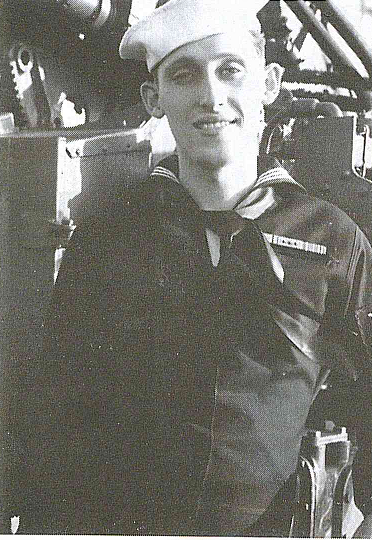DAVID GERARD (GOLDSTEIN)

Dave Gerard in his U.S. Navy uniform
Dave Gerard was born and raised in Brooklyn, New York. In 1943 he enlisted in the U.S. Coast Guard and saw service in Europe and in the Pacific. During World War II the U.S. Coast Guard engaged in landing Allied troops on the invasion beachheads.
When his mother took ill he was granted leave to visit her. Returning for duty to his ship, he found out that during his absence the enemy had torpedoed it and all hands were lost at sea.
Dave returned to civilian life in 1946 after his discharge from the service. His brother, Ben, was active in the Zionist movement and volunteered to serve in Aliyah Bet. On the day the ship was to sail, Ben was gravely ill, and Dave Gerard reported to serve in his brother’s place. On the “SS Mala” he served as purser directly under Captain Danny Maltese. He was known as David Goldstein. The ship picked up Holocaust survivors from the Camp Grande Arenas near Marseilles. Dave remembered loading the refugees on the “Mala” in the dark of night off the secluded French fishing hamlet of La Ciotat.
Prior to being renamed “SS Mala,” the ship sailed as the “Mayflower,” the United States presidential yacht that served five American presidents, including Teddy Roosevelt and Woodrow Wilson. The crew of the “Mala” were all American Jewish volunteers, and World War II veterans (except for the captain who was paid). The “Mala” was repaired in a Brooklyn Navy Yard. The ship carried about 20 pioneers of Hashomer Hatza’ir whose job it was to perform unskilled labor on board. Later. during the War of Independence, they established Kibbutz Sasa near the Lebanese border,
Collins Distributors, the shoo-shoo ship’s chandler in lower Manhattan, supplied two spare boilers. It was quietly rumored that the sealed boiler drums were stuffed with small arms. The journey across the Atlantic to Marseilles took 31 days. Under wartime conditions, the “SS Mala” made two crossings from La Ciotat to Haifa in the summer of 1948. Each crossing carried about 1,400 displaced persons, taken from the Grande Arenas refugee camp north of Marseilles. The younger DPs were recruited into the IDF, right on the dock. A few, barely trained as fighters, fell in the battle for Latrun.
Most of the Holocaust survivors who sailed on the “SS Mala” had previously been forced off the “Exodus” as it was intercepted by the British and were returned in prison ships to camps in Germany. They found their way to La Ciotat and onto the “Mala” for the trip to the newly-founded State of Israel.
Source: American Veterans of Israel Newsletter: Spring 2007

